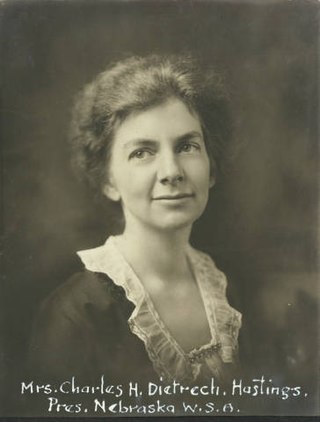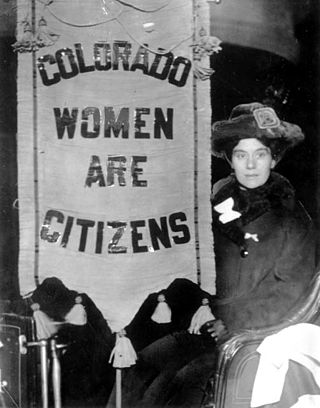
The Nineteenth Amendment to the United States Constitution prohibits the United States and its states from denying the right to vote to citizens of the United States on the basis of sex, in effect recognizing the right of women to vote. The amendment was the culmination of a decades-long movement for women's suffrage in the United States, at both the state and national levels, and was part of the worldwide movement towards women's suffrage and part of the wider women's rights movement. The first women's suffrage amendment was introduced in Congress in 1878. However, a suffrage amendment did not pass the House of Representatives until May 21, 1919, which was quickly followed by the Senate, on June 4, 1919. It was then submitted to the states for ratification, achieving the requisite 36 ratifications to secure adoption, and thereby go into effect, on August 18, 1920. The Nineteenth Amendment's adoption was certified on August 26, 1920.
Universal suffrage ensures the right to vote for as many people who are bound by a government's laws as possible, as supported by the "one person, one vote" principle. For many, the term universal suffrage assumes the exclusion of youth and non-citizens, while some insist that much more inclusion is needed before suffrage can be called universal. Democratic theorists, especially those hoping to achieve more universal suffrage, support presumptive inclusion, where the legal system would protect the voting rights of all subjects unless the government can clearly prove that disenfranchisement is necessary.

Carrie Chapman Catt was an American women's suffrage leader who campaigned for the Nineteenth Amendment to the United States Constitution, which gave U.S. women the right to vote in 1920. Catt served as president of the National American Woman Suffrage Association from 1900 to 1904 and 1915 to 1920. She founded the League of Women Voters in 1920 and the International Woman Suffrage Alliance in 1904, which was later named International Alliance of Women. She "led an army of voteless women in 1919 to pressure Congress to pass the constitutional amendment giving them the right to vote and convinced state legislatures to ratify it in 1920" and "was one of the best-known women in the United States in the first half of the twentieth century and was on all lists of famous American women."

The Silent Sentinels, also known as the Sentinels of Liberty, were a group of over 2,000 women in favor of women's suffrage organized by Alice Paul and the National Woman's Party, who nonviolently protested in front of the White House during Woodrow Wilson's presidency starting on January 10, 1917. Nearly 500 were arrested, and 168 served jail time. They were the first group to picket the White House. Later, they also protested in Lafayette Square, not stopping until June 4, 1919 when the Nineteenth Amendment to the United States Constitution was passed both by the House of Representatives and the Senate.

Women's legal right to vote was established in the United States over the course of more than half a century, first in various states and localities, sometimes on a limited basis, and then nationally in 1920 with the passing of the 19th Amendment.

María Adelina Isabel Emilia "Nina" Otero-Warren was an American woman's suffragist, educator, and politician. Otero-Warren created a legacy of civil service through her work in education, politics, and public health. She became one of New Mexico's first female government officials when she served as Santa Fe Superintendent of Instruction from 1917 to 1929. Otero-Warren was the first Latina to run for Congress, running unsuccessfully in 1922 as the Republican nominee to represent New Mexico's at-large district in the U.S. House of Representatives.

Margretta Dietrich was an American suffragette and activist. She served as resident of the Nebraska Woman's Suffrage Association in 1919 and Chairman of the Nebraska State League of Women Voters in 1920. Following the ratification of the 19th amendment, she went on to advocate for the rights of Indigenous Americans in New Mexico. She was the president of the New Mexico Association of Indians Affairs for more than 20 years and helped found and was the trustee for several organizations that advocated for Native Americans.
This timeline highlights milestones in women's suffrage in the United States, particularly the right of women to vote in elections at federal and state levels.

Women's suffrage was established in the United States on a full or partial basis by various towns, counties, states and territories during the latter decades of the 19th century and early part of the 20th century. As women received the right to vote in some places, they began running for public office and gaining positions as school board members, county clerks, state legislators, judges, and, in the case of Jeannette Rankin, as a member of Congress.
The struggle for women's right to vote in Mexico dates back to the nineteenth century, with the right being achieved in 1953.

Women's suffrage in Virginia was granted in 1920, with the ratification of the Nineteenth Amendment. The General Assembly, Virginia's governing legislative body, did not ratify the Nineteenth Amendment until 1952. The argument for women's suffrage in Virginia began in 1870, but it did not gain traction until 1909 with the founding of the Equal Suffrage League of Virginia. Between 1912 and 1916, Virginia's suffragists would bring the issue of women's voting rights to the floor of the General Assembly three times, petitioning for an amendment to the state constitution giving women the right to vote; they were defeated each time. During this period, the Equal Suffrage League of Virginia and its fellow Virginia suffragists fought against a strong anti-suffragist movement that tapped into conservative, post-Civil War values on the role of women, as well as racial fears. After achieving suffrage in August 1920, over 13,000 women registered within one month to vote for the first time in the 1920 United States presidential election.
Aurora Lucero-White Lea was an American folklorist, writer, and suffragist. She was a proud Nuevomexicana, advocating for bilingual education in English and Spanish and working to preserve the heritage of the Hispanic Southwest. Lucero-White Lea is best known for her 1953 work Literary Folklore of the Hispanic Southwest, a compilation of cultural traditions, songs, and stories collected while traveling northern New Mexico.
This is a timeline of women's suffrage in New Mexico. Women's suffrage in New Mexico first began with granting women the right to vote in school board elections and was codified into the New Mexico State Constitution, written in 1910. In 1912, New Mexico was a state, and suffragists there worked to support the adoption of a federal women's suffrage amendment to allow women equal suffrage. Even after white women earned the right to vote in 1920, many Native Americans were unable to vote in the state.
The fight for women's suffrage in New Mexico was incremental and had the support of both Hispanic and Anglo women suffragists. When New Mexico was a territory, women had the right to vote in school board elections. When New Mexico created its state constitution in 1910, it continued to allow women to vote in school elections, but it was nearly impossible to modify the constitution for suffrage any further. Women in the state chose to pursue advocating for a federal women's suffrage amendment. They organized among both English and Spanish speaking groups. Many New Mexico politicians supported suffrage on a federal level. Continued advocacy on behalf of suffragists in the state allowed New Mexico to become the 32nd state to ratify the Nineteenth Amendment on February 21, 1920.

Ada McPherson Morley was an American author, suffragist and rancher. Early in her time in New Mexico, she and her husband edited a newspaper and took on the Santa Fe Ring both in print and in business matters. Morley became involved with the New Mexico chapter of the Women's Christian Temperance Union (WCTU) and later served as president. She was also involved in women's suffrage in New Mexico and helped recruit women into the Congressional Union (CU) later in her life. Morley owned a ranch in the Datil Mountains where she raised cattle and was able to host meetings.

Women's suffrage in Colorado had an early victory, being the second state to grant women's suffrage and the first to do so through a voter referendum in 1893. Even while Colorado was a territory, lawmakers and other leaders tried to include women's suffrage in laws and later in the state constitution. The constitution did give women the right to vote in school board elections. The first voter referendum campaign was held in 1877. The Woman Suffrage Association of Colorado worked to encourage people to vote yes. Nationally-known suffragists, such as Susan B. Anthony and Lucy Stone spoke alongside Colorado's own Alida Avery around the state. Despite the efforts to influence voters, the referendum failed. Suffragists continued to grow support for women's right to vote. They exercised their right to vote in school board elections and ran for office. In 1893, another campaign for women's suffrage took place. Both Black and white suffragists worked to influence voters, gave speeches, and turned out on election day in a last-minute push. The effort was successful and women earned equal suffrage. In 1894, Colorado again made history by electing three women to the Colorado house of representatives. After gaining the right to vote, Colorado women continued to fight for suffrage in other states. Some women became members of the Congressional Union (CU) and pushed for a federal suffrage amendment. Colorado women also used their right to vote to pass reforms in the state and to support women candidates.

This is a timeline of women's suffrage in Colorado. Women's suffrage efforts started in the late 1860s. During the state constitutional convention for Colorado, women received a small win when they were granted the right to vote in school board elections. In 1877, the first women's suffrage referendum was defeated. In 1893, another referendum was successful. After winning the right to vote, Colorado women continued to fight for a federal women's suffrage amendment. While most women were able to vote, it wasn't until 1970 that Native Americans living on reservations were enfranchised.

Suffrage in New Jersey was available to most women and African Americans immediately upon the formation of the state. The first New Jersey state constitution allowed any person who owned a certain value of property to become a voter. In 1790, the state constitution was changed to specify that voters were "he or she." Politicians seeking office deliberately courted women voters who often decided narrow elections. Due to women's influence as swing voters, they were used as scapegoats to blame for election losses.

This is a timeline of women's suffrage in New Jersey. Women and African Americans had the right to vote in New Jersey until the state constitution was changed in 1807, disenfranchising all but white men. Any early suffrage protest was taken by Lucy Stone in 1857 who refused to pay her property taxes because she could not vote. Additional attempts to make women more equal under the law took place in the 1880s and 1890s. There were also several court cases that challenged women's right to vote in the state. Eventually, a voter referendum on a state constitutional suffrage amendment took place in 1915, however the measure was voted down. Activists continued to fight both in the state and to protest in Washington, D.C. as Silent Sentinels. By February 10, 1920, New Jersey ratified the Nineteenth Amendment.













